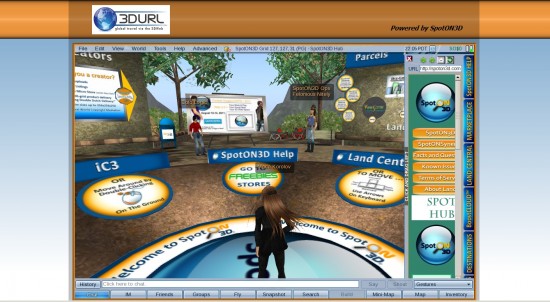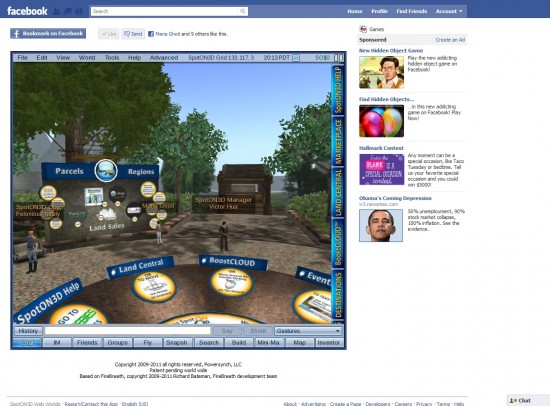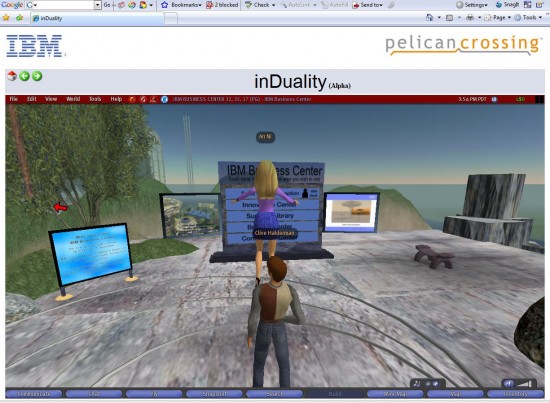Competing OpenSim hosting companies are concerned that SpotON3D‘s viewer plugin patent isn’t original, will hinder innovation, and that the company isn’t playing fair with the broader open source community.
Other developers, however, say that SpotON3D’s innovation can help energize OpenSim adoption — and the patent, if it is granted, may not be that burdensome to the community.

The patent’s opponents include Kitely, an OpenSim hosting company with a Web-based viewer a key part of its future development, and LiteSim founder Gareth Nelson, who created a similar product in 2009. LiteSim was also a virtual world hosting company but has since gone under.

According to Kitely CEOÂ Ilan Tochner, a SpotON3D patent will hurt innovation.
“We can’t afford to fight this battle alone and the community can’t afford for this battle not to be fought,” Tochner told Hypergrid Business, calling on the community to come together to keep the patent from being granted. “It will also force small companies to start spending resources on patents instead of actually making something useful.”
Kitely is a two-man, self-funded startup that currently has no revenues — it’s been hosting more than 900 regions for free for beta customers while it works to improve its on-demand technology. Meanwhile, SpotON3D has $300,000 in startup funding and 12 paid developers, according to co-founder Tessa Kinney-Johnson, and currently runs a little over 200 regions.
Kitely isn’t in direct competition with SpotON3D — it offers on-demand regions and allows customers to save copies of their regions locally via OAR files. SpotON3D runs a traditional grid architecture with always-on regions, and is a closed grid — exports of full regions are restricted. But a successful patent claim by SpotON3D, if broad enough, could potentially interfere with Kitely’s development.
SpotON3D’s chief direct competitors are InWorldz and Avination, each of which is more than four times the size of SpotON3D. However, the viewer plugin and the Facebook integration scheduled for September might attract new customers and allow the grid to jump ahead of the competition.

All OpenSim-based grids — and even Second Life itself — could potentially benefit and attract users new to virtual worlds if the users were able to access the worlds via a website or a Facebook page, without having to download and install special viewer software.

According to patent attorney Lawrence Rosen of Rosenlaw & Einschlag, competitors are legally allowed to use patent-pending technology while the Patent Office is making its decision — which could take four to five years or more.
“But would you design a product that could potentially turn into a massive business, only to learn that in a couple of years you could be paying huge patent fees?” he asked.
This is a concern also for Tipodean, a company that makes a Web-based OpenSim viewer called BuiltBuy.me. Tipodean CEO Chris Collins asked SpotON3D to answer some questions about the viewer, such as what the patent covers.
“You have said clients should just use the tech as the patent is not approved,” he said. “This is hard for me to do as I cannot tell them what is coming.”
Prior art
One front in a potential patent battle is to show the patent office that SpotON3D’s technology is nothing new.
“This is not a particularly novel idea nor is the implementation very complicated,” said InWorldz software architect David Daeschler, commenting as Tranquillity Dexler on a discussion on the  Metaverse Traveller blog.
One example of previous implementations of this idea is inDuality, a tool created by PelicanCrossing and IBM in 2007 that allowed users to access a number of virtual world clients via a Web interface. (Read CNET review here.)

“I used inDuality in 2007 -2008 which was rendering the Second Life client in a browser,” Tipodean’s Collins told Hypergrid Business. “It was cool.”
PelicanCrossing has ceased operations without finding a market for this technology, and the tool is no longer available.
Another potential precedent is Gareth Nelson’s bare-bones plugin, which has also failed to evolve into a viable commercial product.
“What nerve!” Nelson said in response to SpotON3D’s patent claims. “I’ll prior art their ass.”
LiteSim is still available to download as a plugin for Firefox.
“It could theretically work with other browsers with some work,” said Nelson.
He then offered some technical advice for how to do it: “To try it out, you’ll need to get the Gecko SDK. Once you have the Gecko SDK installed, you can compile the code using SConstruct.”
Both inDuality and LiteSim take existing Second Life viewers and package them up inside browser plugins. In a more generic sense, there are plenty of products out there that package up other types of software inside plugins, including viewers for other virtual world platforms.
For example, Alon Zakai, currently a software engineer at Mozilla, demonstrated a proof of concept last year for a browser plugin that runs a viewer for the Syntensity 3D game engine.

“Embedded apps in a web page are very common, with a wide range of open source and proprietary libraries to assist in doing that as SpotOn3D have used,” said Austin Tate, director of the Artificial Intelligence Applications Institute at the  University of Edinburgh, in a comment. Tate is also known as Ai Austin in Second Life.
“The U.S., though, does tend to be more lax with initial granting of such patents which gives the lawyers a bit more to do,” he added.
According to Rosen, there are procedures that opponents of a particular patent can follow when the patent is being granted, before it is granted, and even after it is granted, to ask the Patent Office to reexamine the patent.
“But you have to know the patent application number,” he added. SpotON3D has not yet released its patent application number.
In addition, the decision of whether to fight a patent or not is a strategic one, and requires the assistance of an attorney capable of analyzing such patent claims. Rosen says he can advise a company about the risks that could affect an open source project, or companies relying on that open source project. But for strategic advice and analysis of patent claims, he would refer people to lawyers who specialize in that, such as his partner, Michael Einschlag.
Critics spotlight SpotON3D licensing issues
Some critics have argued that SpotON3D’s new viewer plugin is in violation of the viewer license terms.
Linden Lab released its viewer software under the GPL license — an open source license that does not allow proprietary derivative works. Anyone who builds a product based on the Second Life viewer must also release their source code and license their product as GPL.
The GPL license issue is completely separate from the patent issue, said Rosen. Rosen’s area of expertise is in open source software and open standards, and he has served as general counsel for the Open Source Initiative. The open source license terms of the underlying viewing software is not an issue that the Patent Office considers.
“What you patent are functions, processes, methods — things that you invent,” he told Hypergrid Business. “I don’t care whether that’s a derivative work or a work from Mars, if its a function that is patentable, then nobody can perform that function without a license.”
However, those concerned about the GPL license of the underlying code have other avenues to pursue to force SpotON3D to open up its code.
For example, depending on how closely the plugin is integrated with the viewer code, it may be considered a derivative work, and not a standalone piece of software. If its derivative, then it must be open sourced as well.
“The legalities of using GPL licensed code in this way are questionable and highly dependent on the method used for interaction between the plugin and the GPL licensed viewer code,” said InWorldz’ Dexler.
According to LiteSim’s Gareth Nelson, getting one of the Second Life viewers to work correctly inside a browser window takes some tinkering with the viewer’s source code.
“How do you integrate your plugin with the viewer without modifying the viewer?” he asked SpotON3D. “You can’t just alter the render target. There are changes to the input handling needed to make it work inside a browser plugin applet, so you patched the viewer too. Therefore, your claim that the plugin is 100 percent separate is false.”
As a result, Nelson said, people have the right to see the source code for the plugin.
According to SpotON3D cofounder and CEO Stevan Lieberman, who is also an intellectual property attorney with Greenberg & Lieberman, the company is in full compliance with GPL license requirements and has publicly released the relevant code elements.
“The plugin is an entirely separate program that has been designed to and does work on not only OpenSim, but also on numerous other programs,” he said in a comment at New World Notes. Â “The technology encompassed in the plugin is patent pending world wide as well as copyrighted.”
According to Lieberman, SpotON3D customers will be able to use the plugin to embed the viewer into their websites so that visitors will be able to access their SpotON3D regions.
Other users may need to pay license fees.
“To ensure that SpotON3D has the necessary funding and investment support it is necessary to capitalize on SpotON3D’s patent assets,” Lieberman said.
SpotON3D’s other open source problem
SpotON3D’s services are based on two major pieces of open source software. One is the GPL-licensed viewer, a derivative of the Second Life viewer, which customers use to visit their grid. The other is the OpenSim software that actually runs their grid.
This is similar to the distinction between the browser used to visit a Website — Internet Explorer, Firefox, or Chrome — and the underlying server software used to put the Website on the Web, typically Apache.
The open source code for the OpenSim virtual world software is distributed under a BSD license. This means that companies can modify it and resell those modifications without releasing them back to the community. Unlike with the viewer, derivative works do not have to be open sourced themselves.
And, in fact, many major backers of OpenSim, including IBM, do distribute commercial, proprietary versions of the software.
But most also contribute back in some way — bug fixes or new features, interface improvements, documentation, testing, even simply finding bugs and sharing details of when they appear.
According to SpotON3D’s critics, the company has been using the OpenSim software to make money — without sharing any of the improvements they’ve been making. This is legal, but it’s not nice, critics say.
“If we let this type of behavior go unchecked inside the OpenSim community then it will split the ranks and dissuade companies, including Kitely, from contributing code towards the common goal of an open metaverse,” said Kitely’s Tochner.

SpotON3D’s Kinney-Johnson said the company would contribute code back if it could.
“But we are blocked from contributing code, due to the fact that all our core coders regularly view and work on client code,” she said in a comment.
Since the OpenSim server software uses a different, and incompatible, license than the viewers, if OpenSim was contaminated by viewer code, it could hurt its business-friendly BSD license.
“We’d not want to be the ones to force the Opensim project into GPL status by abusing those rules,” Kinney-Johnson added.
And even if the rule prohibiting programmers from working on both viewer and server code was abolished as a result of the recent formation of a foundation to handle OpenSim licensing issues, other issues are involved as well, she said in a later comment, including the fact that much of the code that SpotON3D created has to do with features unique to SpotON3D grids — the multi-grid user registration, inventory and avatar systems, economy, marketplace, multi-grid content delivery platform, as well as beefed up content protection and security measures.
And it costs money to run the company, she said. “We are a for-profit project with over $300,000 invested and we do have bills to be paid and people to pay.”
Not a threat
To some developers, the SpotON3D patent is not a threat — it’s either a positive for the community, or can be easily circumvented, or is not core to the way that OpenSim works.
“Sure it’s a new idea, and that brings excitement,” said Alexsandro Pomposelli, CEO of the AvWorlds grid. “But it does not demonstrate any great functionality to have the viewer embedded in the browser. What’s the use of it? I myself would not waste time on it. I myself would prefer to have a normal Facebook plugin with a regular [standalone] viewer login. It’s more stable, and more secure.”
Tipodean’s Collins, who was previously general manager of the enterprise division at Linden Lab, also sees the excitement around the new approach — and its technical shortcomings.
“It is great,” he said. “And if it energizers the community, that is even better. There is a great energy for virtual worlds usage within organizations that I have not seen in a while. We are seeing a good amount of investment being spent on relevant options from several companies which benefit all users of virtual worlds.”
Meanwhile, SpotON3D’s approach — which downloads an existing viewer and puts it into a plugin wrapper — suffers from some of the same disadvantages as inDuality.
“It did not help with machines that could not run the Second Life client,” he said, explaining that the Second Life viewer and its derivatives all require a high-end graphics card and a fast computer to work well. Tipodean’s approach is to create a new viewer from scratch, using the Unity 3D platform.
“It can run on much lower-end machines,” he said. “Which, for Tipodean, is something we are really focused on. We want to get more users into virtual worlds.”

Meanwhile, according to OpenSim core developer Crista Lopes, professor of informatics at the University of California, Irvine, SpotON3D’s patent might not be that significant to folks working on the core OpenSim server software.
“I doubt this one is infrastructural in nature,” she said. “It may very well be bogus, like so many patents, but probably doesn’t pertain to the server side.”
And the patent filing itself might not even be about staking a claim to a particular technology, she added.
“In the vast majority of cases, patents are filed to attract investors, not to protect ideas in the original intent of the patent system,” said Lopes.
Note: When contacted by telephone, Tessa Kinney-Johnson declined to comment for this story and referred all questions to SpotON3D CEO Stevan Lieberman. As of the publication of this article, Lieberman has not responded, and neither Kinney-Johnson nor Lieberman replied to our emails.
- OSgrid back online after extended maintenance - April 16, 2025
- Analysts predict drop in headset sales this year - March 25, 2025
- OSgrid enters immediate long-term maintenance - March 5, 2025
